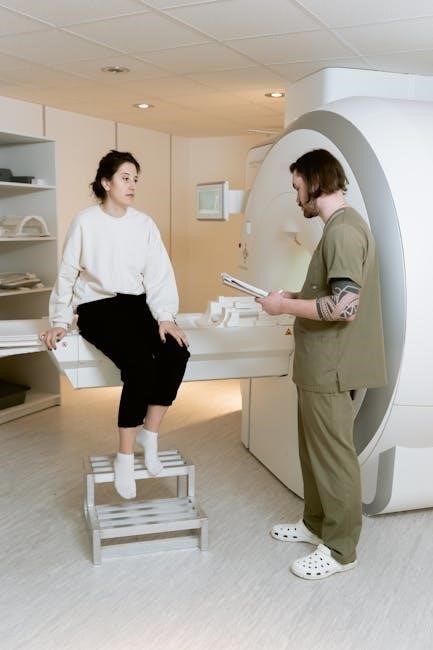1600 calorie meal plan high protein pdf
A 1600 calorie meal plan is a dietary approach that involves consuming 1600 calories per day, with a focus on high protein intake, using a downloadable pdf for easy planning and tracking purposes online.
Overview of High Protein Diet
A high protein diet is a type of diet that emphasizes the consumption of protein-rich foods, such as meat, poultry, fish, eggs, and dairy products, as well as plant-based options like beans, lentils, and tofu. This type of diet is often recommended for individuals who are trying to lose weight or build muscle, as protein can help to promote feelings of fullness and support muscle growth. A high protein diet can be tailored to meet individual calorie needs, such as a 1600 calorie meal plan, and can be planned and tracked using online resources, including downloadable pdfs. The key to a successful high protein diet is to focus on whole, unprocessed foods, and to limit intake of sugary and processed foods. By following a high protein diet, individuals can expect to see improvements in their overall health and wellbeing, including weight loss, improved blood sugar control, and increased muscle mass. A well-planned high protein diet can be a healthy and sustainable way to achieve nutrition goals.

Benefits of High Protein Meal Plan
High protein meal plans offer numerous health benefits, including weight loss and improved muscle mass, using online resources and downloadable pdfs for planning and tracking purposes effectively always.
Importance of Protein in Weight Loss
Protein plays a crucial role in weight loss, as it helps to build and maintain muscle mass, which in turn increases metabolism and burns calories. A high protein diet can also help to reduce hunger and increase feelings of fullness, making it easier to stick to a calorie-restricted diet. According to online resources, a 1600 calorie meal plan with high protein can be an effective way to lose weight and improve overall health. The importance of protein in weight loss cannot be overstated, as it provides the body with the necessary building blocks for muscle growth and repair. By incorporating high protein foods into a 1600 calorie meal plan, individuals can expect to see significant weight loss results, as well as improved overall health and wellbeing. This is supported by downloadable pdfs and online meal planning resources, which provide guidance on how to create a high protein meal plan that meets individual calorie needs.

Sample 1600 Calorie Meal Plan
A sample meal plan includes breakfast, lunch, and dinner options, with a focus on high protein foods and balanced nutrition, available in a downloadable pdf format online easily always.
Breakfast Options with High Protein
Breakfast options with high protein are essential for a 1600 calorie meal plan, providing energy and satiety throughout the morning. A typical high protein breakfast includes eggs, Greek yogurt, and lean meats.
Some examples of high protein breakfast foods are egg omelets, avocado toast with scrambled eggs, and Greek yogurt with nuts and seeds.
These breakfast options can be easily incorporated into a 1600 calorie meal plan, with a focus on balanced nutrition and portion control, using a downloadable pdf for planning and tracking purposes.
A high protein breakfast helps to support weight loss and overall health, making it a crucial component of a 1600 calorie meal plan, with a variety of options available to suit different tastes and dietary needs.
By including high protein foods in breakfast, individuals can help to regulate their appetite and support their overall health and wellbeing, making it easier to stick to a 1600 calorie meal plan.

Macro Breakdown of 1600 Calorie Meal Plan
Macro breakdown typically includes carbohydrates, protein, and fat, with specific ratios for a 1600 calorie meal plan, using online resources for planning and tracking nutritional information daily always.
Calculating Protein Requirements
To calculate protein requirements, individuals should consider their weight, activity level, and fitness goals, using online calculators or consulting with a nutritionist for personalized recommendations.
A general guideline is to consume 0.8-1.2 grams of protein per kilogram of body weight daily, with athletes or those who are trying to build muscle requiring more protein.
Protein requirements can also be calculated based on caloric intake, with a typical range of 15-20% of daily calories coming from protein.
Using a 1600 calorie meal plan as an example, this would translate to 60-80 grams of protein per day, although this may vary depending on individual needs and circumstances.
It is also important to consider the quality of protein sources, with high-quality proteins like lean meats, fish, and eggs providing all essential amino acids.
By calculating protein requirements and incorporating high-quality protein sources into a 1600 calorie meal plan, individuals can ensure they are meeting their nutritional needs and supporting overall health and well-being.
Online resources and meal planning tools can help simplify the process of calculating protein requirements and creating a personalized meal plan.

Free 1600 Calorie Meal Plan Resources
Online resources offer free downloadable pdf meal plans and tracking tools for easy planning and organization purposes daily.
Downloadable PDF Version of Meal Plan
A downloadable pdf version of the meal plan is available online, allowing users to easily access and print out their personalized 1600 calorie high protein meal plan. This pdf version can be used to plan and track daily meals, ensuring that users stay on track with their dietary goals. The pdf version typically includes a detailed breakdown of daily meals, including breakfast, lunch, dinner, and snacks, as well as a list of approved foods and portion sizes. Users can also use the pdf version to make adjustments to their meal plan as needed, such as swapping out ingredients or changing the portion sizes. Overall, the downloadable pdf version of the meal plan is a convenient and useful tool for anyone following a 1600 calorie high protein diet. With this resource, users can easily stay organized and focused on their dietary goals, and make healthy eating a sustainable part of their lifestyle.



























